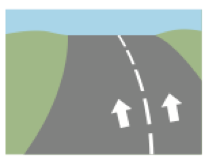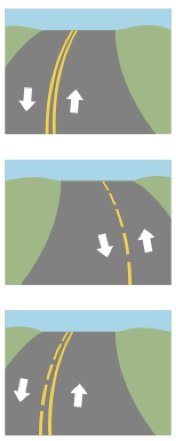Session 10 – Rules of the Road 3
RULES OF THE ROAD cont.
PAVEMENT MARKINGS
Lines and symbols on the roadway divide it into lanes, tell you when you may pass other vehicles or change lanes, and which lanes to use for turns. They define pedestrian walkways and show where you must stop for signs or traffic signals. Line colors tell you if you are on a one-way or two-way roadway.
Edge and Lane Lines. Lines along the side of the road show you where the edge of the road is located. A solid white line indicates the right edge of the traffic lane on a road. A solid or dashed yellow line indicates the left edge of traffic lanes going in your direction. If you ever find yourself with yellow to your right and white to your left, you are going the wrong way.
White lane markings. Multiple lanes of travel in the same direction are separated by white lane markings. You will find white lane markings on freeways and one-way streets, for example.
Dashed white lines between lanes of traffic mean you may cross the lines to pass or change lanes if it is safe to do so.
A solid white line between lanes of traffic means you should stay in your lane unless a special situation requires you to change lanes. You should not cross the line except to avoid a hazard or unless you are turning within the next block.

Crosswalks and stop lines. Crosswalks define the area where pedestrians may cross the roadway. Crosswalks can be at intersections or in the middle of the block. You must yield to pedestrians who are in or are about to enter a crosswalk (marked or unmarked). When required to stop because of a sign or signal, you must stop before the front of your vehicle reaches the stop line. If there is no marked stop line, stop before entering the marked crosswalk on the near side of the intersection. If there is no marked stop line nor a marked or unmarked crosswalk, stop at a point nearest the intersecting roadway where you have a clear view of approaching traffic, but before entering the intersection.
Yellow lane markings. Lines separating traffic moving in opposite directions are yellow.
Two solid yellow lines between lanes of traffic means neither side can pass. You may cross a solid yellow line to turn into a driveway if it is safe to do so.
Dashed yellow lines mean you may pass, but watch for oncoming traffic
Some passing zones have signs that tell you where you cannot pass. Where there is both a solid and a dashed yellow line between opposing lanes of traffic, you may not pass if the solid yellow line is on your side. If the dashed line is on your side, you may pass if it is safe to do so.

